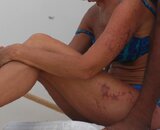Getting the bends isnt a crime or a sin. Its something that needs to be dealt with to prevent it from getting worse and REALLY becoming problem. And when we tell you, whether its a local trip or a foreign trip, that if after a dive youre feeling SOMETHING UNUSUAL FOR YOU . . . then you need to let us know. In Audreys case, she did the exact right thing once she realized there was a problem.
We put Audurey on oxygen and I ordered the boat to pull anchor and head back towards La Paz. Skin bends sometimes resolves with oxygen alone but I needed to get close enough to La Paz to get within cell phone range so we could contact the D.A.N. emergency line and get some advice and perspective on what was going on. And if need be, there was a chamber in La Paz (as well as one in Cabo) so that if Audrey did need to be treated, we could get her in as quickly as possibly. (Unlike in the U.S., you cant count on a helicopter to come get you so the usual course of action is to head back to port.)
The short version is that we kept Audrey on oxygen, her symptoms resolved, D.A.N. agreed with our skin bends suspicion, and no chamber treatment was required. It was recommended that she stay out of the water for at least 48 hours (which meant no more diving on the trip) and that shed be OK to fly after that but we should watch for any recurrence of symptoms during the flight.
Ken,
Just seeing this now because I don't frequent this forum. I completely agree with the first paragraph above, i.e. it's not a sin to get DCS.
I do wonder about the advice you received about not needing to treat this diver because her symptoms resolved on O2. DCS symptoms can and do resolve on surface O2. They also can and do reoccur after the O2 is discontinued, and the recurrence can be worse than the initial symptoms. The symptoms you described ("bruised or mottled skin") sound more like cutis marmorata than simple skin bends. Cutis is associated with more severe neurological DCS symptoms. If this diver did indeed have cutis, she should have been evaluated and treated in a hyperbaric chamber, even though the rash resolved.




